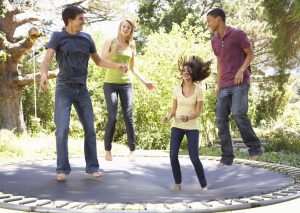
7 Differences Between Competitive Trampoline & Fun in the Backyard
1 CommentYou may have caught the trampoline competitions at this year’s Olympic Games. The world watched in awe as athletes sprung 20 feet into the air and flipped multiple times before going right back up and flipping multiple times again.
 Although these athletes likely inspired many children to gain interest in a sport they may or may not have participated in prior to the Olympic Games, it is important to note that there are many differences between competitive trampoline and the trampolines you see in people’s backyards. Read below to discover seven of these differences, as well as ways to enhance your child’s safety when on a trampoline.
Although these athletes likely inspired many children to gain interest in a sport they may or may not have participated in prior to the Olympic Games, it is important to note that there are many differences between competitive trampoline and the trampolines you see in people’s backyards. Read below to discover seven of these differences, as well as ways to enhance your child’s safety when on a trampoline.
- The Trampoline Bed: The material used to weave the bed of a backyard trampoline is different than the material used on competition trampolines, and so are the springs. For instance, the springs that connect the trampoline bed to the base are much higher quality on competition trampolines. These differences allow a different amount of spring and tension for the trampolinist, allowing the competitive athlete to jump higher and with improved mechanics at the ankles, knees and hips than is possible on a backyard trampoline. An athlete that can safely perform double or triple rotations within a skill is not able to do the same safely on a backyard trampoline.
- Basic Training: Competitive trampolinists start with the basics so that the athlete knows how to safely fall and land. Front drops, back drops, seat drops and straight jumps teach the athlete to land with head control, body control and with the arms in. Jumping mechanics for proper knee and hip positioning are also emphasized for the competitive trampolinist. Without these basic skills, an individual is at risk for injury, including fractures, whiplash and soft tissue tears.
- Spotters: Spotters are required during a trampoline competition. Approximately six spotters surround the trampoline with their eyes fixed on the athlete. The spotters are there to help guide the athlete back onto the trampoline bed in the event that the athlete doesn’t hit the center and ends up close to the edge or the springs. Conversely, children jumping on a trampoline in the backyard usually do not have spotters watching or constant supervision to make sure they stay in the middle, which can increase the risk of injury.
- Mats: Several mats are required during a trampoline competition. Platforms with mats sit at either end of the trampoline and mats are also placed on the floor surrounding the trampoline. These mats help to improve safety in case an athlete lands incorrectly and is projected outside of the trampoline bed.
- Number of Jumpers: The sport of trampoline emphasizes that a single jumper is the only safe way to jump on a trampoline. Although a synchronized trampoline competition includes two competitors, they are positioned on trampoline beds that are side by side rather than on the same trampoline. When two jumpers are on a trampoline at the same time, one jumper impacts the recoil of the other, which puts an unnatural force on the second jumper’s joints. In addition, there is a risk of collision that can lead to injury.
- In-Ground Practice Trampolines: Many trampoline gyms have in-ground trampolines. A hole dug in the ground allows the athlete to jump on the trampoline at ground level. This enhances safety, as the risk of an athlete falling off of the trampoline at an increased height is reduced. Backyard trampolines do not have this option.
- Marks on the Trampoline: Competition trampolines are marked with a cross in the middle that is a contrasting color to the trampoline bed. This allows the athlete to spot and have a guide as to where to land. Jumping in the middle of the trampoline is important for the athlete to make sure they go straight up and down and don’t shoot off to the side of the trampoline. Backyard trampolines are not marked, which can make it difficult to land in the right spot and increases the risk of injury.
Trampolines are definitely a fun activity for both the athlete and recreational participant, but it is important to be safe and prevent injury whenever possible. If an injury does occur, make sure to contact your physician or schedule an appointment for a free injury screen at your nearest Athletico location.
Click to Schedule a Complimentary Injury Screen
The Athletico blog is an educational resource written by Athletico employees. Athletico bloggers are licensed professionals who abide by the code of ethics outlined by their respective professional associations. The content published in blog posts represents the opinion of the individual author based on their expertise and experience. The content provided in this blog is for informational purposes only, does not constitute medical advice and should not be relied on for making personal health decisions.


1 Comment
Larry Dunn
I think I am going to buy a competitive trampoline soon. The post is very good and detailed. Thanks for sharing!